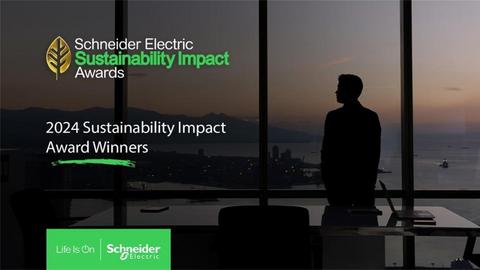Analyses & Studies
How Singapore’s most sustainable industrial building generates more energy than it uses

Climate Impact Partners recognizes that “climate commitments among the Fortune Global 500 continue to grow, but greater ambition and scope of the targets is needed.” Further, the Net Zero Stocktake 2023 report reveals that companies making net-zero commitments are not often supporting those goals with credible plans.
These observations emphasize the need for careful planning to transform climate ambition into action. This is why Schneider Electric’s 3-step approach to net zero is proving successful. It’s helping them and their customers:
- Strategize a practical roadmap
- Digitize operations to support data-driven decisions and
- Decarbonize all three emissions scopes within new or existing facilities.
For example, their Technopole building in Grenoble, France, achieved net-zero operation and a LEED Platinum rating. Another recent success comes from Singapore, where the new headquarters of leading construction group Samwoh Corporation sets a national benchmark for innovation and sustainability.
They recently spoke with Sam Pang, Deputy Chief Operating Officer of Samwoh, to discuss their sustainability approach.
What inspired the development of your sustainability vision?
The government’s Singapore Green Plan 2030 introduced ambitious targets, including greening 80% of buildings (by gross floor area), ensuring 80% of new developments are Super Low Energy buildings, and achieving an 80% improvement in energy efficiency for best-in-class green buildings by 2030. Samwoh Corporation supports these goals by taking action to drive the transformation towards a greener, low-carbon urban environment.
How did Schneider Electric contribute to optimizing energy usage at the Samwoh Smart Hub?
To maximize energy efficiency in their new headquarters, they selected two trusted partners who shared their goals for sustainability and innovation in support of a greener future. They worked closely with Schneider Electric and its local system integrator DG Energy Controls to help their Smart Hub maximize energy efficiency while optimizing its chiller plant system. DG Energy Controls delivered a tailored solution based on Schneider Electric’s EcoStruxure™ Building Operation next-generation building management system (BMS).
How did the EcoStruxure platform improve energy use visibility and control within the building?
EcoStruxure Building Operation is part of a connected ecosystem of smart devices, software, apps, and services that seamlessly collects all real-time energy consumption and production data. The system delivers several capabilities:
- PowerLogic power meters, PowerTag wireless sensors, smart MasterPact MTZ, and ComPact NSX circuit breakers accurately measure energy use in real time. These technologies allow real-time energy tracking via BMS so their facilities team can collect historical energy data and make sound decisions on system optimization.
- SpaceLogic smart sensors optimize temperature and humidity based on occupancy.
- EVlink Smart Wallbox EV charging stations offer metering, reporting, billing, and remote maintenance capabilities.
- The BMS continually monitors and analyzes the building’s energy, helping them make informed decisions to improve energy performance. For example, it uses pre-chilled water in their thermal energy storage (TES) tank to optimize the energy consumption of chillers without compromising thermal comfort of the building.
- The open, future-ready digital building platform includes cloud-based analytics and a centralized dashboard to unify energy and utility data monitoring across their Smart Hub facility. With this consolidated overview of the energy consumption levels across individual technologies, they can better understand electrical patterns and optimize usage with just a click. The system also alerts the Samwoh team of any power risks and warns of any equipment abnormality, allowing the facilities team to tackle equipment faults before a system failure occurs.
These capabilities have enabled increased efficiency while optimizing on-site renewables, helping them decarbonize and realize a 50% savings in annual utility costs.
In addition, the solutions delivered by Schneider Electric and DG Energy Controls helped their Smart Hub achieve the prestigious BCA Green Mark Platinum (Positive Energy) for Industrial Buildings Award.
How does the Samwoh Smart Hub generate more energy than it consumes?
The building is powered by 2,588 solar panels. With these panels, they are looking at harvesting 950,000 kWh to 1,100,000 kWh per annum. The building is highly efficient, using less than 60 kWh of energy per square meter yearly. As a result, they can send 25% of the solar electricity they generate back to the national grid. This makes their new headquarters Singapore’s first industrial building that produces more energy than it consumes.
How can other companies model the Samwoh Smart Hub’s success?
The Samwoh Smart Hub is the first industrial building of its kind in Singapore to achieve this exceptional level of efficiency and sustainability. It shows what is possible with strong partnerships, planning, and technologies. Together with Schneider Electric, they are committed to creating a future where every building in Singapore is a symbol of progress and environmental stewardship. This includes setting meaningful examples for the industrial built environment sector to help achieve the nation’s green goals.
What future innovations or plans does Samwoh have to further enhance its energy-positive status?
Beyond the energy-positive headquarters, their team is constantly looking into improving the energy efficiency of current systems. They are also optimizing their operations and business activities for sustainability while promoting a sustainable and green culture amongst their employees.
SOURCE: Schneider Electric


